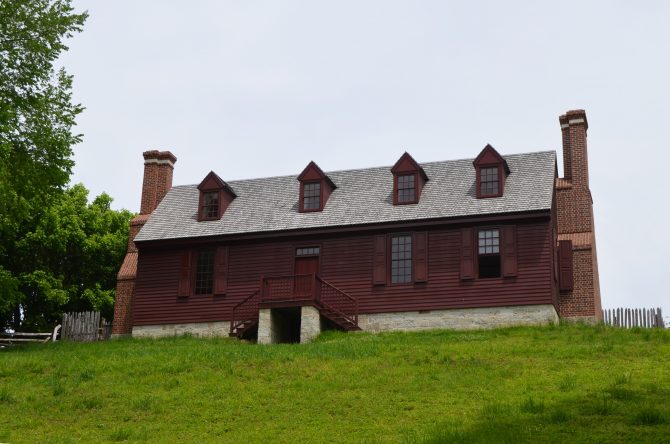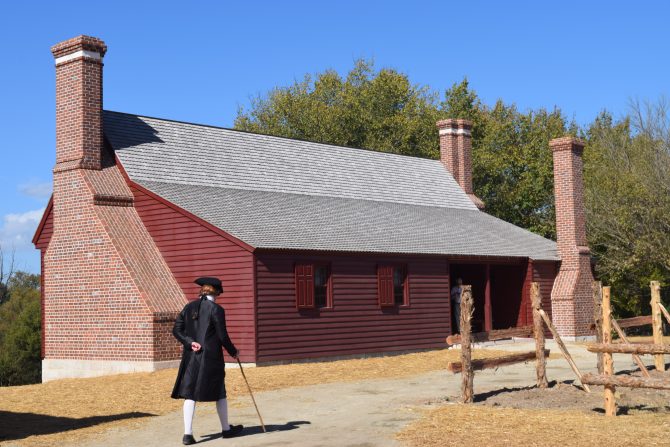By Jerrilyn Eby
Ferry Farm is best known as the childhood home of George Washington, though it has a history that predates the Washington occupancy.
Augustine Washington bought the property in 1738 from the heirs of William Strother (c.1700-1732). Strother had first lived at the family estate, Millbank, in King George County and served as a justice for that county. When Millbank burned, Strother bought 260 acres on the Rappahannock directly across from Fredericksburg. At that time the property was situated in King George County. Not until the King George-Stafford County boundary was changed to Muddy Creek in 1777 did the Strother farm become part of Stafford.
Strother died in 1732 and the farm was advertised for sale in The Virginia Gazette of April 21, 1738. The advertisement described the farm as:
“all that Messuage Tenement and Mansion House where the said William Strother lately Dwelt and all those several pieces of parcells of land thereunto adjoining and upon which the said Mansion stands containing together by Estimation Two Hundred and Eighty Acres…and all the Houses, out houses, Edifaces, etc.” The plantation included “a very handsome Dwelling house, 3 Store houses, several other convenient Outhouses and a Ferry belonging to it.”
William Strother had amassed a sizable estate by the time he died in 1732. His inventory listed 22 slaves. After his death, his wife married John Grant.
At the time the Washingtons purchased the Strother farm, it consisted of two tracts, a 100-acre parcel which included the house site and a 180-acre “Quarter.” Augustine purchased additional adjoining land to increase the size of his farm to 580 acres. He named the property Ferry Farm because of the ferry that operated on the shore below the house. The ferry had been authorized in 1728 to transport people from King George County to Fredericksburg.
Ferry Farm was the third Washington farm and the third home for George, then seven years old. George spent ten years at Ferry Farm; he didn’t move away permanently until 1748 when he went to Mount Vernon with his brother, Lawrence. At the time of Augustine’s death in 1743, an inventory listed 20 slaves, and horses, hogs, sheep, and cattle totaling 71 had at the 100-acre home site. The 180-acre “Quarter” had 7 more slaves and 40 head of livestock. The remaining 300 acres was composed of forest and open fields. Upon his father’s death, George inherited Ferry Farm, ten slaves, and three lots in Fredericksburg. However, he did not take possession of the property until he came of age. His mother continued to live on the farm until 1772. George sold Ferry Farm sometime between 1772 and 1776.
While the dwelling may not have been the “Mansion House” mentioned in the Strother advertisement, it was nonetheless a substantial home for the period. There were at least seven rooms in the original house. The inventory made after the death of Augustine listed a “Hall,” a “Hall Back Room,” a “Parlour,” a “Back Room,” a “passage,” a “Hall Chamber,” and the “Parlour chamber.” There were also several storehouses, a dairy, a kitchen, and a poultry house.
It is not known when or how the Ferry Farm house disappeared. It may have been destroyed or torn down in 1772. Washington advertised the property for sale in The Virginia Gazette on November 5, 1772, and the ad included no mention of a house. The advertisement noted that the tract had “one of the most agreeable Situations for a House that is to be Found on the whole River having a clear and distinct View of almost every House in town, and every Vessel that passes to and from it.” Today all that is left of the old buildings is one small building, most likely the surveyor’s office.
George was eleven years old when his father died, and he remained at Ferry Farm for another five years, moving to Mount Vernon in February 1748 to live with his older brother Lawrence. Upon the death of his sister-in-law in 1759, George inherited Mount Vernon. Sometime between 1772 and 1776, George sold the Ferry Farm (which he had inherited from his father) to Dr. Hugh Mercer of Fredericksburg. Mercer apparently purchased the property with the intention of starting a town there. He planned on calling the new settlement Mercer Town and hoped that some of the prosperous Falmouth merchants would open businesses in his new town.
Mercer served as a Brigadier General in the Revolutionary War and, unfortunately, was killed in January 1777, leaving his wife, Isabella, and five children. His will stated that all his property was to be inherited by his eldest son, William. In the event William died or was unable to manage the estate, the property was to go to the second eldest, George. Sadly, both William and George were deaf and dumb. Isabella and the executors of the estate, George Weedon and John Tennant, decided to petition George Washington, by then President, to have the land surveyed as Hugh Mercer had intended. The petition stated that the two sons, being deaf and “thereby rendered incapable of managing their Affairs,” were not able to decide upon the best use of the farm. The property was surveyed in 1785 and lots laid out, but there seems to have been some dispute as to William’s abilities and limitations, for the town never came to fruition. The farm remained in the Mercer family until 1826.
On September 12, 1826, a notice appeared in The Virginia Herald advertising “Valuable Property for Sale: Mercer’s Ferry and 500 Acres of Land Adjoining.” The ad noted that “there are already commodious buildings for a plain family…with several beautiful and commanding eminences for a Dwelling upon a large scale, and one site, in particular, that is uncommonly fine.” There was still no reference to a surviving Washington home. The farm seems to have been purchased at this point by Reverend Thomas C. Teasdale. After this, the property changed hands and was divided numerous times until by 1990 the total acreage was only sixty-eight acres. At this time the owners, Samuel and Irma Warren, gave Stafford County the thirty-four acres which included the old house site.
During the Civil War, artillery was located on the higher ground (site of modern Ferry Farm Subdivision) overlooking the city of Fredericksburg. There were pontoon bridge crossings at the old ferry site. Maps of the period show a road leading to the home site. One map shows two building symbols and another map shows three, suggesting that farming continued at Ferry Farm until at least 1863.
Extensive archeological examinations are underway, the results of which will be used to plan a full restoration of the house and dependencies. In 1991, the 1726 cellar was opened and found to contain many artifacts.
In 1996, after a lengthy community-fired effort to prevent a Wal-Mart store from being built next to the Ferry Farm site, the Washington home, and adjoining acreage were purchased by the Kenmore Association, operators of Kenmore House and Gardens in Fredericksburg. This was a fitting buyer for the Washington property since Betty Lewis of Kenmore was George Washington’s only sister.
Notes: This information originally appeared in They Called Stafford Home: The Development of Stafford County, Virginia, from 1600 until 1865, by Jerrilynn Eby, and is posted here with the author’s gracious permission. In recent years, research has revealed much about Ferry Farm, and the site is now open to the public - including a handsome new "interpretive replica" of the Washington house, which opened in May of 2018.



